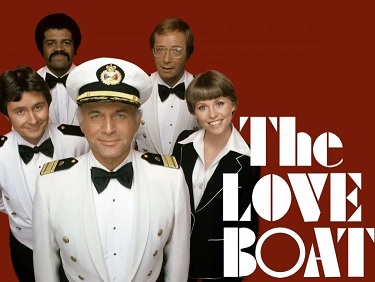Welcome to Retro Television Reviews, a feature where we review some of our favorite and least favorite shows of the past! On Wednesdays, I will be reviewing the original Love Boat, which aired on ABC from 1977 to 1986! The series can be streamed on Paramount Plus!
It’s time for love and monkeys!
Episode 1.14 “Isaac’s Double Standard / One More Time / Chimpanzeeshines”
(Dir by James Sheldon and Richard Kinon, originally aired on January 14th, 1978)
This is a bit of an odd episode.
It’s odd because it features yet another stowaway. Somehow various characters were always managing to stow away on the boat. This week, the stowaway was a chimpanzee. How did a chimpanzee get on the boat? Gopher brought her on. Apparently, Gopher was under the impression that he had the week off so he agreed to look after a friend’s chimpanzee. Then he discover that he actually was working that week so he decided that it would be a good idea to smuggle the chimpanzee onto the boat. Of course, it doesn’t take long for Isaac and Julie to discover that Gopher has a chimpanzee in his cabin. Neither one of them appears to be surprised that Gopher has a friend who owns a chimpanzee. Me, I would want more information on whether or not Gopher’s friend worked for a circus or a zoo or a research lab. I mean, most people just don’t own chimpanzees as pets. Instead, everyone just accepts that Gopher is living with a monkey and that it is now their duty to keep Captain Stubing from finding out.
Of course, the chimpanzee gets loose. She runs around the ship, stealing food and clothes and surprising passengers. Fortunately, she’s a well-trained chimpanzee and she doesn’t try to kill anyone. In real life, Chimpanzees are known for being extremely dangerous and unpredictable. On shows like this, they’re adorable!
While looking for the chimp, Gopher meets and has a romance with Anne Parker (Kim Lankford), who has just had a nose job. She’s insecure about her new nose. Everyone assures her that her new nose looks great. And it does! As someone who spent most of her teen years planning on getting a nose job, I was really impressed with it. (For the record, I still have my original nose and I now realize I wouldn’t change it for the world.)
While Gopher is dealing with the chimp, Isaac is freaking out because his mother (Pearl Bailey) is on the ship with her new boyfriend (Arthur Adams) and they’re sharing a cabin! Isaac is being a little bit hypocritical because he happens to be sharing a cabin with his girlfriend, Charlene (Tracy Reed). Isaac finally realizes he’s not being fair and he accepts the fact that his mother is having sex at his workplace. So, it all works out.
Meanwhile, in our third storyline, Nanentte Fabray is a singer who is hired to provide the cruise’s entertainment. She’s upset to discover that her pianist (Don Adams) is also her ex-partner. Don’t worry, they get back together by the end of the cruise. Of course, everyone’s too busy looking for the chimpanzee to notice.
This was not a terrible episode, just an odd one. The Nanette Fabray/Don Adams storyline was pretty forgettable and, though it’s always cool when Ted Lange actually gets to do something other than make drinks, Isaac’s family situation played out predictably. What made this episode stand out, for better or worse, was all the business with the chimpanzee. How Gopher kept his job after that, I have no idea. Chimpanzees have been known to kill people if they get stressed out and being dragged onto a cruise ship by a stranger seems like it would be a stressful situation. Still, after all that, Gopher kept his job. I’m beginning to think that Captain Stubing might not be the disciplinarian that the crew things he is.
Next week, we’ve got more love but hopefully less monkeys.


 When San Francisco-based private investigator Michael Brennen (O.J. Simpson) gives a ride to Joey Crawford (John Spencer) on Christmas Eve, he doesn’t know that it’s going to lead to the biggest case of his career. When Joey asks Michael to help him track down his ex-girlfriend, Michael assumes that Joey would never be able to pay for his investigative services. But one week later, Michael gets something in the mail from Joey. Inside the envelope, there’s a picture of both Joey’s ex and a thousand dollar bill. Ever after he discovers that Joey was mysteriously killed the night before, Michael decides to take on the case. His investigation will take him not only to Joey’s ex but it will also lead to him uncovering a drug ring that involves one of San Francisco’s most prominent families.
When San Francisco-based private investigator Michael Brennen (O.J. Simpson) gives a ride to Joey Crawford (John Spencer) on Christmas Eve, he doesn’t know that it’s going to lead to the biggest case of his career. When Joey asks Michael to help him track down his ex-girlfriend, Michael assumes that Joey would never be able to pay for his investigative services. But one week later, Michael gets something in the mail from Joey. Inside the envelope, there’s a picture of both Joey’s ex and a thousand dollar bill. Ever after he discovers that Joey was mysteriously killed the night before, Michael decides to take on the case. His investigation will take him not only to Joey’s ex but it will also lead to him uncovering a drug ring that involves one of San Francisco’s most prominent families.
 Running Scared is weird but good.
Running Scared is weird but good.
